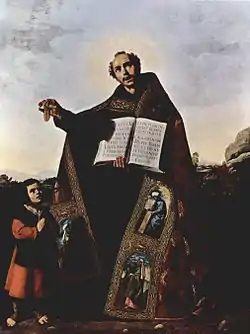Romanus of Caesarea
Romanus of Caesarea (Greek: Ρωμανός), also known as Romanus of Antioch, is venerated as a martyr. A deacon of Caesarea, he was martyred at Antioch.
Saint Romanus of Caesarea | |
|---|---|
_-_relic_of_Romanus_of_Caesarea.jpg.webp) Relic of Romanus at St. Raymond Maronite Cathedral (St. Louis, Missouri), a church named for him. | |
| Died | c. 303 AD |
| Venerated in | Roman Catholic Church, Eastern Orthodox Church, Oriental Orthodox Church, Maronite Church |
| Feast | November 18 |
Life
In 303 or 304, at the beginning of the Diocletianic Persecution, a deacon called Romanus, served in Caesarea in Palestine. He was living in Antioch where in the midst of the persecutions, he encouraged the Christians to stand firm.[1]
During a pagan festival, he upbraided the participants for worshiping idols. Taken prisoner, he was condemned to death by fire, and was bound to the stake. When rain extinguished the flames,[2] Romanus was brought before Emperor Galerius who was then in Antioch. At the emperor's command Romanus' tongue was cut out. Tortured in various ways in prison he was finally strangled.[3]
Eusebius speaks of his martyrdom in De martyribus Palaestinae. Prudentius[4] relates other details and gives Romanus a companion in martyrdom, a Christian by name Barulas. On this account several historians, among them Baronius, consider that there were two martyrs named Romanus at Antioch, though more likely there was but the one whom Eusebius mentions. Prudentius has introduced legendary features into his account, and his connection of the martyrdom of Barulas with that of Romanus is probably arbitrary.[3]
The feast day of Saint Romanus is observed on 18 November.[3] The church of San Román in Seville is dedicated to Romanus. Prudentius wrote a 1140 line hymn to Romanus, the Romane Christi fortis, the tenth hymn in his Peristephanon.[5][6]
Barulas | |
|---|---|
 Saints Romanus and Barulas, by Francisco de Zurbarán. The book says, in Latin, "Blessed Romanus was praying when he said, Lord Jesus Christ, show thy might, that thy holy name may be glorified, which is blessed forever. Pray for us blessed Romanus, that we may be made worthy of the promises of Christ." | |
| Died | 303 |
| Venerated in | Roman Catholic Church, Eastern Orthodox Church, Armenian Apostolic Church |
| Feast | 18 November |
Barulas
Barulas (died 303) was a seven year old boy who was martyred along with Romanus of Caesarea by Emperor Galerius by being whipped and beheaded for their Christian beliefs.[7] Barulas, like Quiricus, is venerated as a child-martyr. His feast day is on November 18.[8]
Barulas was a child in the crowd of people who witnessed the torture of Romanus. Romanus told the Eparch Asclypiades that the boy was wiser than he was, because he knew the true God while the Eparch did not.
Asclypiades asked the boy what gods he worshiped, and he replied that he worshiped Christ. “Your gods are demons,” the child stated, “and they have not created anything.”
With these and other words, the young child put the idolaters to shame. Seeing that he could not convince Barulas to worship the false gods, he had the boy tortured. His mother stood by, encouraging him to remain faithful to his Saviour. After the child was executed, his mother took his body and buried it, rejoicing because he had shed his blood for Christ.
References
- "Martyr Romanus the Deacon of Caesarea", Orthodox Church in America
- Dumitraşcu, Iulian. "Martyrs Platon of Ancyra, Romanus the Deacon of Caesarea, and Zacchaeus the Deacon of Caesarea in Palestine", Biserica Ortodoxă Română
- Kirsch, Johann Peter. "Sts. Romanus." The Catholic Encyclopedia Vol. 13. New York: Robert Appleton Company, 1912. 18 November 2021
 This article incorporates text from this source, which is in the public domain.
This article incorporates text from this source, which is in the public domain. - Peristephanon, X in P.L., LX, 444 sqq. or page 235 of this PDF
- Romane Christi in the Gopher archive at the University of Pennsylvania
- Tycner, M. "Liber Peristephanon, Poem X", The Cult of Saints in Late Antiquity, Oxford Univ.
- Monks of Ramsgate. "Barulas". Book of Saints 1921. CatholicSaints.Info. 19 August 2012
 This article incorporates text from this source, which is in the public domain.
This article incorporates text from this source, which is in the public domain. - Lives of all saints commemorated on November 18
![]() This article incorporates text from a publication now in the public domain: Herbermann, Charles, ed. (1913). "Sts. Romanus". Catholic Encyclopedia. New York: Robert Appleton Company.
This article incorporates text from a publication now in the public domain: Herbermann, Charles, ed. (1913). "Sts. Romanus". Catholic Encyclopedia. New York: Robert Appleton Company.